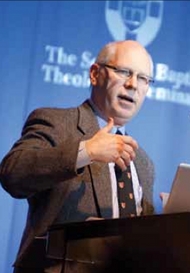 The reason why Jesus reflects both the OT figures of Adam and Israel is, as we observed earlier, that Israel and its patriarchs were given the same commission as was Adam in Gen. 1:26–28. Consequently, it is not an overstatement to understand Israel as a corporate Adam who had failed in its “garden of Eden,” in much the same way as its primal father had failed in the first garden. (Note again OT texts where Israel’s promised land is called the “garden of Eden” (Gen. 13:10; Isa. 51:3; Ezek. 36:35; Joel 2:3).
The reason why Jesus reflects both the OT figures of Adam and Israel is, as we observed earlier, that Israel and its patriarchs were given the same commission as was Adam in Gen. 1:26–28. Consequently, it is not an overstatement to understand Israel as a corporate Adam who had failed in its “garden of Eden,” in much the same way as its primal father had failed in the first garden. (Note again OT texts where Israel’s promised land is called the “garden of Eden” (Gen. 13:10; Isa. 51:3; Ezek. 36:35; Joel 2:3).For these reasons, we recall once again that one of the reasons why Jesus is called “Son of God” is that this was a name for the first Adam (Luke 3:38; cf. Gen. 5:1–3) and for Israel (Exod. 4:22; Hos. 11:1). Recall yet again also that the divine image that Adam was to reflect was expressed more in functional than in ontological terms: Adam was to reflect God’s actions in Gen. 1 of subduing and ruling over creation, creating, and filling the world with his creation. Accordingly, Adam was to “rule and subdue,” “be fruitful and multiply” (i.e., increase the human progeny of the creation), and “fill the earth” with image-bearers who reflect the divine glory. We even saw that the language of “sonship” in Gen. 5:1–3 was essentially descriptive of someone who was in the “likeness” and “image” of his father, so that Adam himself was to be considered a “son” of God because he too was created in the “image” and “likeness” of God (Gen. 1:26; 5:1).
 Likewise, the expression “Son of Man” from Dan. 7:13 refers to end-time Israel and its representative king as the son of Adam who is sovereign over beasts (recall that the Son of Man takes over the kingdoms of former evil empires portrayed as beasts). Understandably, against this background, it is natural that “Son of Man” became one of Jesus’s favorite ways to refer to himself.
Likewise, the expression “Son of Man” from Dan. 7:13 refers to end-time Israel and its representative king as the son of Adam who is sovereign over beasts (recall that the Son of Man takes over the kingdoms of former evil empires portrayed as beasts). Understandably, against this background, it is natural that “Son of Man” became one of Jesus’s favorite ways to refer to himself.Thus, Jesus Christ is the son of Adam, or the “Son of Man,” who has begun to do what the first Adam did not do and to inherit what the first Adam did not inherit, including an end-time glory that was a consummate reflection of God’s image. But he is also the true, end-time Israel, to which the applications of the Dan. 7 Son of Man to Jesus also point strongly, since the Adamic language of “Son of Man [Adam]” is interpreted in Dan. 7 itself first to be the saints of Israel. However, as we saw earlier in this chapter, a careful reading of Dan. 7:13 reveals that the Son of Man is also an individual divine king who corporately represents Israel.
We also saw earlier in this chapter and in chapter 2 that Dan. 7 has multiple allusions to Gen. 1, which enforces the notion of an Adamic background. In this regard, at the risk of being overly repetitive, I want to underscore once again that since the nation Israel bore the mantle of Adam (the Gen. 1:28 commission was repeatedly applied to Israel), it was considered to be a corporate Adam and was also functionally to reflect God’s image (see chap. 2). This identification is a crucial linchpin for the biblical-theological conclusions in this chapter and in others to come. Hence, Jesus’s two roles as the last Adam and true Israel are two sides of one redemptive-historical coin.
Therefore, Jesus came as the end-time Adamic Son of God, representing corporate Israel, and in doing so he was doing what the first Adam should have done in completely obeying God. And in this, he was inaugurating the kingdom of the new creation. And in doing so, he was restoring the functional image of God for those whom he represented. In that Jesus himself was the model Adam, and hence the perfect image of God as the first Adam should have been, all those who trust in and follow Jesus are identified with him as the end-time royal Adam and eschatological image of God.
Beale, G. K. (2011). A New Testament Biblical Theology: The Unfolding of the Old Testament in the New (pp. 428–429). Grand Rapids, MI: Baker Academic.

Comments